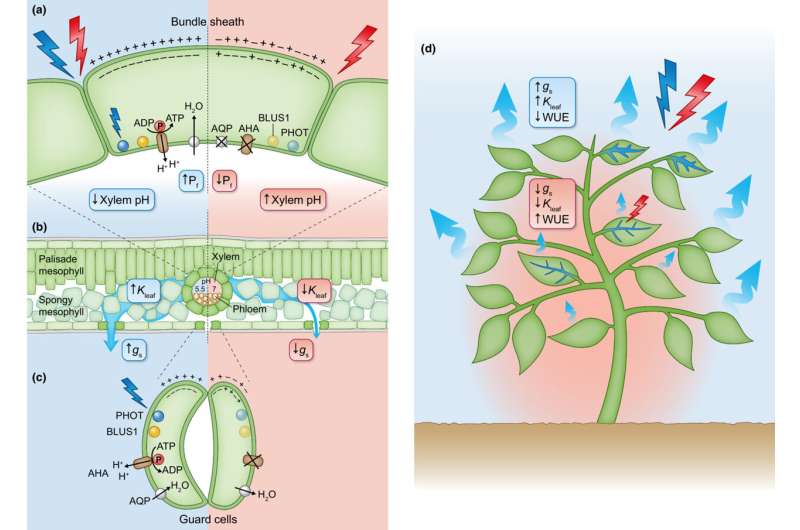
Influence of Light on Plant Ionic-Osmo-Hydraulic Properties and Water Homeostasis. The impact of the complete light spectrum on plant ion and water transport is widely recognized. The light spectrum affects hydraulic conductance at multiple levels, from individual cells to the entire organism. The left side of panels a–c (blue shaded background) describes the processes that occur when a plant is exposed to both Red Light (RL) and Blue Light (BL), initiating the blue light signal transduction pathway (BLSTP) which is crucial for regulating water permeability within (a) vascular bundle-sheath cells (BSCs). In these cells, BL is detected by the phototropins PHOT1 and PHOT2, mediated by the BLUS1 kinase. This activation triggers the H+ATPase proton pump-AHA2, leading to hyperpolarization of the BSCs’ plasma membranes and acidification (pH c. 5.6) of the xylem sap. As a result, the BSCs’ membrane osmotic permeability coefficient (Pf) and the (b) leaf radial hydraulic conductance (Kleaf) increase. (c) A similar BLSTP is found in guard cells (GCs), in which membrane hyperpolarization and apoplastic acidification lead to the accumulation of ions and water, which cause the stomata to open increasing stomatal conductance (gs). This, in conjunction with Kleaf, supports high transpiration rates. Despite the smaller proportion of BL (as compared to RL) in total sunlight, its impact on plant hydraulics is significant. In the absence of BL, described in the right side of panels a–c (red background), depolarization and apoplastic alkalization are observed in both BSCs and GCs, leading to decreased Pf and Kleaf, as well as stomatal closure and reduced transpiration, yet with a lower reduction impact on leaf photosynthesis. At the whole-plant level (d), BL (areas in the figure with blue background) contributes to the increased transport of water toward the canopy edges, where the temperature and vapor pressure deficit (VPD) are significantly higher. This mechanism allows for a greater supply of the water essential for transpiration and cooling processes in these areas. Shaded leaves (red background) receive considerably less BL. However, since those leaves transpire less and are exposed to lower heat and VPD, the reduced presence of BL enhances their water-use efficiency (WUE). Please note that the red background areas of the figure are shaded in red for illustration purposes, but the light spectrum reaching the plant would normally include other waves lengths such as far-red and green, as well as lower BL : RL ratios as described earlier. Credit: New Phytologist (2023). DOI: 10.1111/nph.19497
A recent study led by Prof. Menachem Moshelion from The Robert H. Smith Faculty of Agriculture, Food and Environment at The Hebrew University, along with Dr. Yael Grunwald and Dr. Adi Yaara from the same institute, has unveiled the intricate relationship between light conditions, particularly the Blue-Light (BL) to Red-Light (RL) ratio, and leaf hydraulic conductance (Kleaf) across various canopy areas has been revealed.
The plant canopy, essentially the upper layer of vegetation in a plant, plays a crucial role in light interception and photosynthesis, acting as the vital connection between plants and their surroundings. It is heavily influenced by factors such as light intensity and quality, profoundly impacting photosynthesis—a fundamental process in plant growth.
This investigation unveils how these light variations impact all aspects of plant hydraulic and gas conductance. This study focuses on how the balance of blue and red light in these bright areas helps control the water flow within plant leaves. It does this by affecting the water permeability of cells near the plant’s vascular tissue (the plant’s water transport system), which meets the high water demand.
On the other hand, in shaded areas, where there’s less light, plants have lower water needs. These shaded leaves are more efficient in using water because they lose less water through transpiration, and they still support photosynthesis (a fundamental process) for plant growth due to the presence of red light.
This research explores the intricate mechanisms through which plants adapt to diverse environments, offering crucial insights for optimizing agricultural approaches, especially in regions where water management is critical, and deepening our comprehension of plant physiology.
Conversely, shaded inner-canopy areas experience lower light intensity, reduced water demands, and diminished leaf water transport due to lower intensity and BL induction. Intriguingly, despite these differences, shaded leaves exhibit higher water-use efficiency compared to their counterparts in the upper canopy. This heightened efficiency is attributed to decreased transpiration and cooling requirements in the shaded areas, while the presence of RL supports photosynthesis.
The study sheds light on the dynamic interplay between light conditions, water demands, and hydraulic conductance within different canopy regions, offering valuable insights into the adaptive strategies plants employ to thrive in varying environments.
The findings of this research not only contribute to our understanding of plant physiology but also have potential applications in optimizing agricultural practices, especially in areas where water management is crucial for crop productivity.
The study is published in the journal New Phytologist.
More information:
Yael Grunwald et al, Illuminating plant water dynamics: the role of light in leaf hydraulic regulation, New Phytologist (2023). DOI: 10.1111/nph.19497
Citation:
Illuminating plant water dynamics: The role of light in leaf hydraulic regulation (2024, January 17)
retrieved 17 January 2024
from https://phys.org/news/2024-01-illuminating-dynamics-role-leaf-hydraulic.html
This document is subject to copyright. Apart from any fair dealing for the purpose of private study or research, no
part may be reproduced without the written permission. The content is provided for information purposes only.
>>> Read full article>>>
Copyright for syndicated content belongs to the linked Source : Phys.org – https://phys.org/news/2024-01-illuminating-dynamics-role-leaf-hydraulic.html































